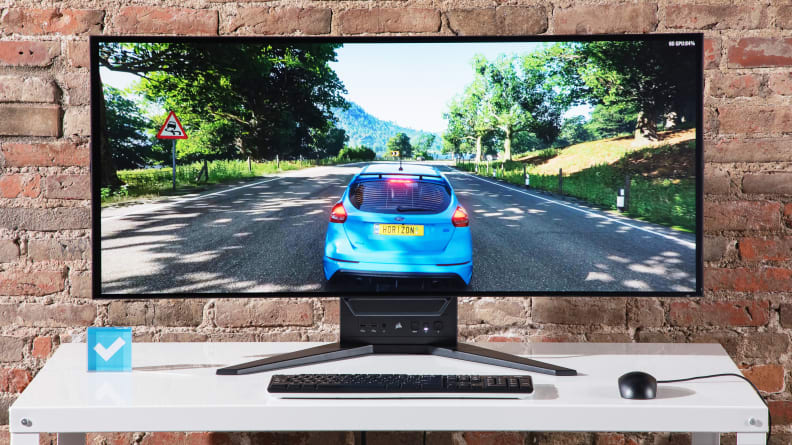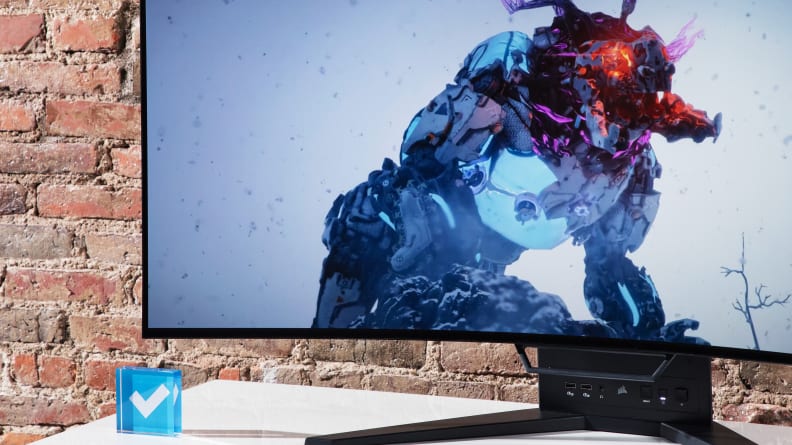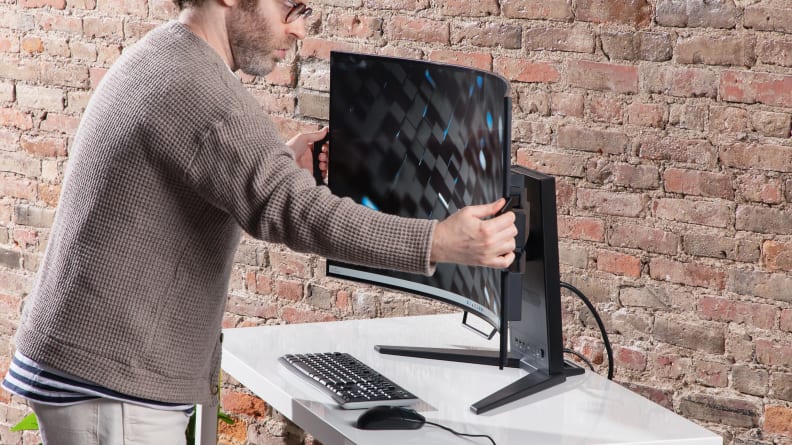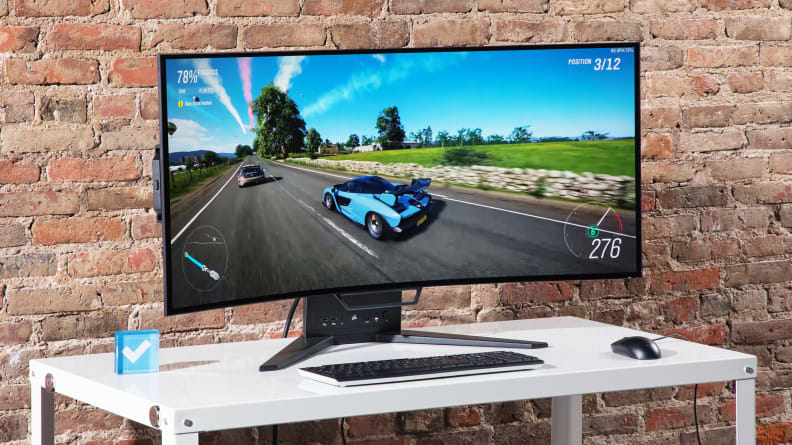Cons
-
Aggressive auto dimming
-
Limited range of motion
-
Expensive
The Corsair Xeneon Flex is so close to great, but can’t hack day-to-day tasks.
About the Corsair Xeneon Flex

Credit:
Reviewed / Timothy Renzi
The Corsair Xeneon Flex’s special features include adaptive sync, an ultrawide screen, and impressive HDR performance.
Here are the specs of the model we tested:
- Price: $2,000
- Display size: 45 inches
- Resolution: 3440 x 1440 pixels
- Refresh rate: 240Hz
- Peak brightness: 450 nits (rated for 25% window), 1000 nits peak with HDR enabled (rated); 390 nits (tested with 25% window), 135 nits (tested with 100% white screen), 661 nits with HDR enabled (25% window tested)
- HDR support: VESA DisplayHDR10
- Color depth: 10-bit
- Color saturation: 100% sRGB (rated), 98.5% DCI-P3 (rated); 99.87% sRGB (tested), 95.43% DCI-P3 (tested), 90.29% AdobeRGB (tested)
- Contrast ratio: 1,500,000:1 (rated)
- Pixel response time (GtG): 0.03ms
- Ports: 1x DisplayPort 1.4, 2x HDMI 2.1, 1x USB Type-C 3.2 (DP alt mode) with 65 watts of power delivery, 1x USB-C 3.2 (Upstream), 4x USB-A 3.2, microphone in, 3.5mm headphone out
- VRR Support: VRR, AMD FreeSync Premium, G-Sync compatible
- Warranty: 3-year protection from burn-in and dead pixels
- Other features: Bendable panel up to 800R curvature, built-in metal handles, integrated KVM, picture-in-picture
The Corsair Xeneon Flex is a 21:9 ultrawide that measures 41.95 x 22.63 x 12 inches when flat and shrinks to 39.14 inches wide when fully curved. Three handles are attached to the screen, one on each side that can be pulled out to bend the monitor back and forth, and another on the bottom for tilt adjustment up and down. Unfortunately, the monitor can’t be separated from the stand and VESA-mounted, though Corsair has promised a proprietary monitor arm is coming.
At the time of writing, the Xeneon Flex isn’t supported in Corsair’s iCue software hub, but the monitor will eventually be integrated.
What we like
Color and clarity you expect from OLED

Credit:
Reviewed / Timothy Renzi
The Corsair Xeneon Flex cost around $1,600 to $2,000.
The first thing I noticed after turning on the Corsair Xeneon Flex for the first time (aside from its massive size on my desk) was that I didn’t have to adjust the color temperature to get a pure, neutral white. Corsair calibrates and verifies the Xeneon Flex before shipping, an added perk that I wish more expensive monitors would include (looking at you, AOC AGON PRO AG274QZM).
In fact, I never even bothered calibrating the Xeneon Flex. Out of the box, I measured an average Delta E value (the difference between a specified color value and what the monitor is putting out) of just 0.5, and a maximum of 1.5—a Delta E value of under 1.0 is good enough for professional work, and most people can’t even spot a difference below 2.0 with the naked eye.
My eye isn’t trained well enough to spot those minuscule differences in color, but I was particularly stunned by the vibrancy and accuracy of how the Xeneon Flex displays reds. Contrast is also excellent, as you’d expect from an OLED panel since those turns pixels off entirely to reach perfect black levels with no light bleed-through.
This means games look as brilliant as you’d expect, especially if they’re able to take advantage of an ultrawide resolution. Exploring dark caves in Returnal or dusky highlands in Horizon Zero Dawn always felt engrossing and realistic, and thanks to the 240Hz refresh rate and instant pixel refresh times, there’s no juddering or smearing either.
While there have been complaints online about the Flex’s relatively low resolution given its 45-inch size—that’s a pixel density of 82 pixels per inch, about the same as a 27-inch, 1080p monitor—it’s not really noticeable in games, apart from the odd jagged effect here or there on far-away objects. The “screen door” effect is negligible given how large the monitor is; you should be sitting at least 24 inches away anyway.
Still, given that 34-inch ultrawides like the Alienware AW3423DW and ASRock Phantom Gaming PG34WQ15R2B have the same resolution, it’s understandable that some gamers would like a higher pixel density in a $2,000 display. I’m able to max out games just fine with an Nvidia RTX 3080 on the Xeneon Flex, so personally, I’m glad buyers won’t need to drop $1,500 on an RTX 4090 just to use this monitor.
Fantastic HDR performance
Color accuracy and a wide gamut are matched by equally good HDR performance. I was only able to measure about 661 nits across a 25% window thanks to the monitor’s auto brightness limiter, but the highlights pop in games to a level comparable with other HDR1000 displays we’ve tested.
While this makes games look more realistic (traipsing through dark alleys in Final Fantasy VII Remake looks especially good), it also makes the Xeneon Flex great for watching movies, TV shows, and HDR YouTube videos.
Black-and-white content also stands out, and although it can’t get as bright in SDR, the picture quality looks about as good as the LG C2 in my living room. It makes sense that they’d be similar, as Corsair is using an LG-made WOLED panel for the Xeneon Flex instead of a QD-OLED like the Alienware AW3423DW.
A bending display is more useful than you think
When I first unboxed the Corsair Xeneon Flex, I was taken aback by how much screen space the massive monitor provides. I daily drive dual 27-inch, 1440p displays on a monitor stand and angle them inward towards the center, so I wanted to replicate that experience when I temporarily replaced them with the Xeneon Flex.
I divided the Xeneon Flex down the middle with FancyZones to create two separate workspaces to recreate my multi-monitor set-up. It seems counterintuitive, but the nearly-square aspect ratio of each section is perfect for reading and writing text thanks to the additional height. And because you can bend each side independently, I found myself tweaking them for the perfect viewing angle (although viewing angles are uniformly quite good across the entire display).
Corsair rates each Xeneon Flex for 10,000-15,000 bends, which should last the entire life of the monitor for most use cases. I bent it back and forth to adjust the screen position about two to three times a day, including to the full 800R curvature for widescreen games.
In action games like Horizon Zero Dawn, having such a large screen around you feels totally immersive, even if it makes the HUD elements at the edges a bit harder to read. Then, when I switched to RPGs like Divinity: Original Sin 2 or Pathfinder: Wrath of the Righteous, I flattened the panel out again to have all of my abilities readable at once.
But after bending the display over and over again every day for two weeks, I couldn’t get it totally flat again. Despite pushing on the handles as hard as I dared for fear of breaking it, I couldn’t get rid of the slight curves at the panel’s edges. The monitor flattened out (and stayed flat) when I laid it face-down for disassembly, but that’s not something the average user will, or should, do.
What we don’t like
The aggressive brightness limiter

Credit:
Reviewed / Timothy Renzi
Corsair rates each Xeneon Flex for 10,000-15,000 bends.
OLED displays like the Corsair Xeneon Flex dynamically limit how much power is being delivered across the screen based on what content is being displayed as a protective measure to, in part, keep the pixels from overheating and wearing down prematurely. This means larger expanses of white will be dimmer overall than a mixture of darker and lighter areas. Despite the Xeneon Flex’s impressive screen real estate and color accuracy, it fails at being a good productivity monitor owing to how dim it becomes when large expanses of white are onscreen and how rapidly the brightness fluctuates.
Although it can hit 400 nits in SDR, that’s only across a small area on a dark background. With two white Scrivener windows open side-by-side, or a Scrivener window and a website in light mode, I measured the brightness at a paltry 161 nits. With a fully white screen, I only measured 135 nits.
I’m a little biased as I like to run my monitors on the brighter side, but the bigger issue is how rapidly brightness fluctuates depending on the content you’re looking at. With a white window on one side and a YouTube video open on the other (even in dark mode), the brightness across the entire monitor noticeably fluctuates during the video enough to be distracting. Of course, this is a problem endemic to OLEDs in general, but 27-inch monitors like the Asus ROG Swift OLED PG27AQDM promise full-white brightnesses of around or over 250 nits thanks to heatsinks on the back of the panel.
The Xeneon Flex does have a brightness limiting mode in the settings menu that can lock the display at about 150 nits no matter what you’re looking at, and this might be okay if you’re using it in a dim room. It was a tad too dark for me and I ended up disabling it.
Limited range of motion
While the monitor’s stand is nicely decorated in Corsair’s signature tessellating triangles and has an excellent selection of ports on both the front and back, there’s no height adjustment, swivel, or pivot. You can bend the Xeneon Flex, or tilt it up or down about 22 degrees using the metal handle under the screen. That’s it.
Because the panel needs to bend, Corsair has shunted all of the electronic components into the base. That means it isn’t removable, making the Flex the rare ultra-pricey monitor that isn’t VESA compatible. Corsair has promised that the Xeneon Flex will be arm-compatible at some point (with a proprietary system most likely), but until then, you’ll have to use the stand.
It really is fine apart from the limited range of motion, but I noticed the screen jiggling around whenever I bumped my desk. The feet are also quite long as they need to stabilize a very large, very heavy stand, so make sure that your desk is at least 24 inches deep.
You’ll pay a king’s ransom
When it isn’t on sale, the Corsair Xeneon Flex retails for a cool $2,000. It’s understandable that a first-generation iteration of a new product would cost more, and ultrawides and super-ultrawide monitors do tend to cost more, but it’s still a big price tag regardless of your budget.
For the same price, you could buy two LG UltraGear OLED 27GR95QE-B and sit them side-by-side for a max resolution of 5120 x 1440 (though it won’t be uninterrupted screen space). Or, better yet, you could buy one ultrawide OLED gaming monitor, like the Alienware AW3423DW or cheaper AW3423DWF exclusively for gaming, and still have enough left over for an IPS monitor for productivity work.
If you pick up the AW3423DWF and the 27-inch, 1440p, 240Hz Gigabyte M27Q X, for example, you can have a bright display on one side that’s speedy enough for competitive games and still take advantage of a widescreen OLED whenever you need it for about $1,500 total.
If you can snag the Xeneon Flex on sale, it becomes a much more enticing proposition. At $1,600, that’s a hair more than the very similar LG 45GR95QE-B but with the added ability to go flat when you need it.
The limited range of motion is still a bummer, but being able to adjust the curvature of a desk-dwarfing display puts the Xeneon Flex above a fully curved monitor in my mind. Of course, $1,600 is also a lot of money, and if you want a truly cheap OLED gaming monitor and are willing to sacrifice on quality of life features, the 42-inch LG C2 has gone on sale for as low as $650.
Should you buy the Corsair Xeneon Flex?
Maybe, if you’re willing to pay the early adopter tax

Credit:
Reviewed / Timothy Renzi
The Corsair Xeneon Flex is a 21:9 ultrawide that measures 41.95 x 22.63 x 12 inches when flat and shrinks to 39.14 inches wide when fully curved.
The Corsair Xeneon Flex is a cutting-edge monitor, and you’ll pay accordingly. It has all of the bells and whistles you’d want from a top-tier gaming monitor—a 240Hz refresh rate, near-instantaneous pixel response times, and an OLED panel—along with tons of connectivity and, of course, the ability to literally bend it to your will.
If you exclusively want a fantastic, albeit a bit lower resolution, OLED gaming monitor, you should consider the Xeneon Flex. But if you’re only going to buy one display and plan on using it for both work and play, I’d look elsewhere; while the contrast and color accuracy make this a monitor that seems like it would be good for everything, the aggressive brightness limiter really does put a damper on productivity work.
It’s not a deal-breaker in my eyes, but the lower resolution also leaves longer pages of text with a jagged look around the edges that might annoy some people. For $2,000 (or even $1,600), I expect more pixel density, but these issues are also more about the constraints of OLED technology right now rather than the Xeneon Flex specifically. If you don’t need a massive monitor that wraps around you completely while gaming, consider a 34-inch curved OLED gaming monitor like the Samsung Odyssey G85SB or the Alienware AW3423DW instead.
You’ll need a beefy pair of monitor arms for this setup, but pairing that ultrawide OLED with a productivity monitor, even a top-tier one like the 2560 x 2880 LG Dual Up, will cost about the same as the Xeneon Flex. (A single arm will run about $100, while a brand-name option from Ergotron can cost up to $399 for one ultrawide-capable arm. Whatever you buy, make sure it’s rated to hold your monitor’s weight.)
Still, if you do want a truly unbeatable gaming experience, consider the Corsair Xeneon Flex. Even after going back to my normal setup, my plain old 27-inch monitors feel way too small. If Corsair can hit 200 nits at 100% white screen on the next version of the Flex, I’d buy it in a heartbeat.

Corsair Xeneon Flex
The Corsair Xeneon Flex has fantastic FDR and is loaded with connectivity.
The product experts at Reviewed have all your shopping needs covered. Follow Reviewed on Facebook, Twitter, Instagram, TikTok, or Flipboard for the latest deals, product reviews, and more.
Prices were accurate at the time this article was published but may change over time.
Meet the tester
Jonathan is an Electronics Editor for Reviewed specializing in gaming gear and has experience with everything from controllers to benchmarking the latest GPUs. He was previously the Web Editor at The Architect’s Newspaper.
Checking our work.
Our team is here for one purpose: to help you buy the best stuff and love what you own. Our writers, editors, and lab technicians obsess over the products we cover to make sure you’re confident and satisfied. Have a different opinion about something we recommend? Email us and we’ll compare notes.











